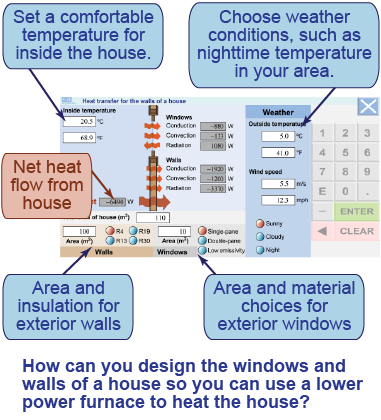| | Essential questions | | How quickly does heat move? | |
|
No object in our environment stays at a constant temperature for very long. As temperature changes everything, including our bodies, constantly exchanges heat with the environment and other objects. In this investigation you will model the heat flow through a wall of a typical home. 
|
Part 1: How heat transfer is balanced for a house
 The interactive model shows a wall with windows that represent the heat transfer properties for a typical house.
The interactive model shows a wall with windows that represent the heat transfer properties for a typical house. - To start, choose a wall area of 90 m2 with R4 insulation (which means it is uninsulated). Enter a window area of 10 m2 with single-pane glass.
- Set the inside temperature to 21ºC, outside to 0ºC, and wind speed to 1 m/s, and choose a sunny day.
- Describe the heat that flows and its distribution among convection, conduction, and radiation.
- How does the heat transfer change when the wind speed is increased to 15 m/s?
- How does the heat transfer change when the outside conditions change from sunny to cloudy to night?
- Suppose the furnace can produce 15,000 W of heat. How high can you set the inside temperature before the furnace cannot keep up?
- If there is a large, net heat transfer
into the house, what might you want to install inside? 
|
In this interactive simulation, you will learn about the heat transfer through the walls of a house. You can modify the size and material of the walls and windows of the house. You can also change the outside weather conditions and the inside temperature that the house’s thermostat and furnace maintain. How do the different parameters affect the conduction, convection, and radiation of heat either into or out of the house?
|
Part 2: House conditions appropriate to your area
- Set the parameters to be typical for houses in your area and use R13 wall insulation.
- Set the outside weather conditions to nighttime values typical for winter in your area.
- Set the inside temperature to a value you consider to be comfortable, such as 21ºC (70ºF).
- How much heat must the furnace of your house produce to balance the heat transfer out of the walls and glass?

|
Part 3: Going further
- Design and carry out a virtual experiment to determine the effect of “R-value” in terms of heat transfer through the wall.
- Design and carry out a virtual experiment that determines the effect of different window construction options in sunny, cloudy, or night conditions.
- What are the effects of “R-value” on heat transfer through the wall?
- Describe the parameters of the
control used throughout this investigation. How did you use the control in the investigation? Why is it useful to have a control? 
| |
| |
|

